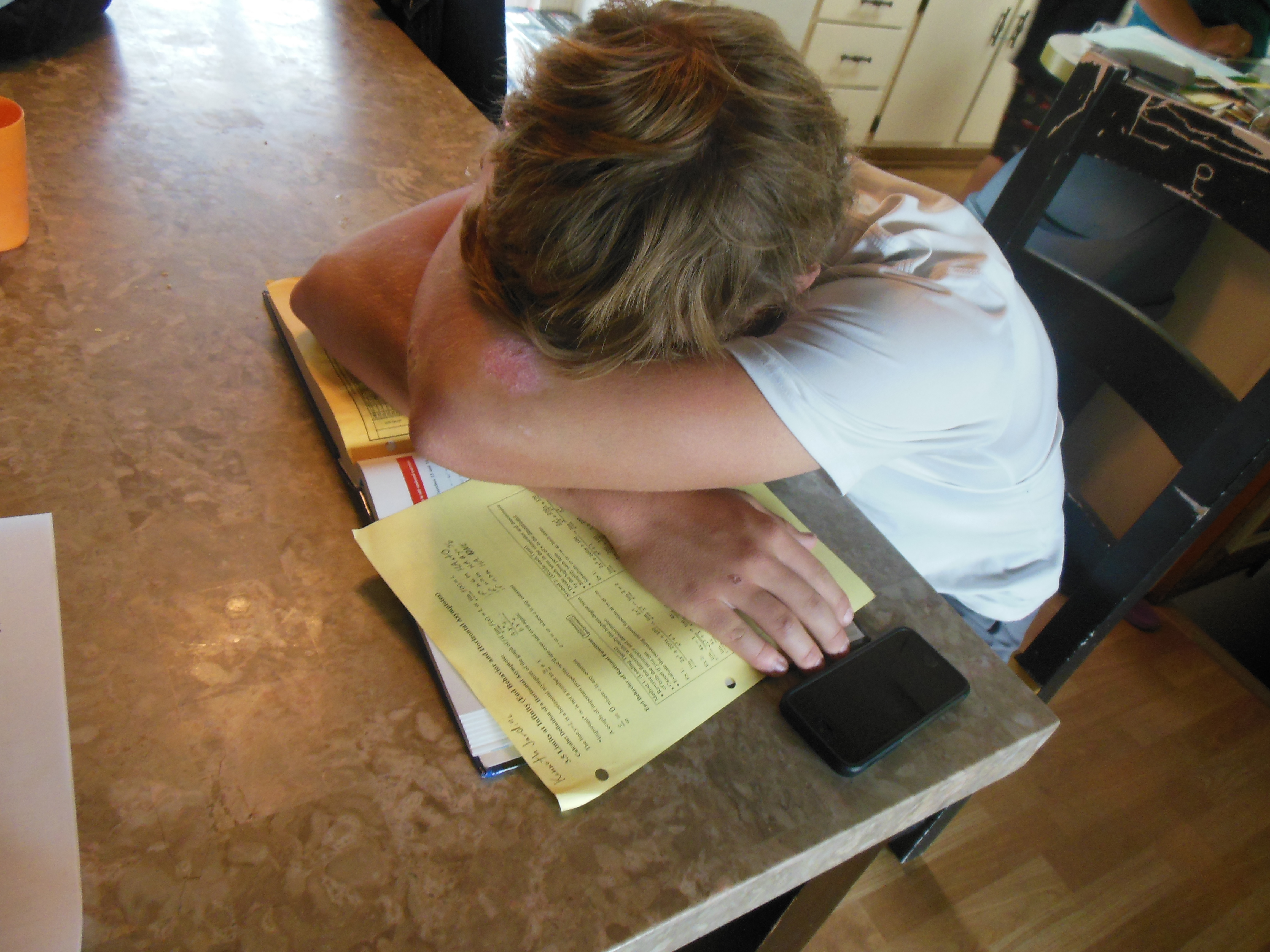By William Lambert
There are croutons in a plastic container, and next to that a few mugs with chai tea lie cooling. Ed Pollei (whose home I’m sitting in) sets a camera down in front of me, playing footage on the viewfinder of a documentary shot by Daniel Nelson. He’s the subject of the documentary, telling an obviously fake story about the making of his very real film, Fried Egg. He smiles smugly, shaking his head. Trevor Allen asks him how the test in AP Gov and Citizenship went for him. From the sound of things they both have done poorly, but with no fault to be placed on the students: most of the vocabulary was never mentioned in class. A cursory google turns up a definition for certiorari: “a writ or order by which a higher court reviews a decision of a lower court.”
Daniel, Fried Egg’s star, arrives. The conversation diverges, and they discuss what they want to shoot tonight. Once they agree to shoot the “library scene” they focus in on what props they’ll need, specifically which book Daniel ought to inspect. Before making a final decision on what to do with Daniel’s literature, they talk about what lenses they’ll need. Edward is the director of photography, claiming the final say in this sort of thing, but he does appreciate Trevor’s input. Trevor turns to me, suddenly, and mentions that he’ll have a shooting schedule finalized soon, primarily so that his actress can line up her schedule with his. If she can’t make it, though, Ed tells me they have a backup, though for whatever reason they are hesitant to divulge exactly who that backup is.
Just as quickly as the topic was brought up, it is dropped, as we gather around a computer to watch a few scenes from Kubrick’s A Clockwork Orange. I am amazed by the amount they’re able to glean from just a few minutes of film, all the effort they see that is completely invisible to me. After about 10 minutes of Clockwork, as they call it, they greet their second actor for the night: Kelton Wagley. Kelton is playing a ghost, and, as such, requires a ghost costume. After a quick discussion over whether the eyes should be a) cut or b) drawn for the Great Pumpkin-esque ghost costume, they decide that drawing black dots will fit their needs perfectly. Ed’s mom brings home some pizza, and I eat with the crew. Trevor talks a bit about school. A simple and non-sequiturial interjection by Daniel sets the crew down a Youtube rabbit hole that begins with the production cards for Illumination Entertainment, and ends with behind the scenes footage of the 2002 Scooby-Doo movie. All this occurs as Daniel chants some sort of Minecraft parody. Eventually, they ask me to drive them to the library. I agree, and strangely enough, we are out in a few minutes.
According to the British Film Institute, 698 films were released in cinemas in 2013. While it’s more likely than not that Fried Egg won’t appear in cinemas, it will be finished “sometime before the end of the year” according to Trevor. Conceived by Ostentatious Productions LLC (composed of Ed Pollei, Trevor Allen, and Jack Leonard), Fried Egg will be the first short film produced by the company. Focusing on the mental deterioration of Daniel after his friend, Jonny, goes missing, the film has an idiosyncratic character to it, a blend of absurdist humor and cinematographic style accumulated from cinema’s greatest auteurs.
Ed is Fried Egg’s cinematographer. Trevor works closely with him to set up shots, using a variety of gear that Ed’s accumulated over the year. Most of the time, Ed says, Trevor gives him some sort of reference for shooting, i.e. “a Kubrick shot” or “a Star Wars pan.” Ed is the most technically inclined crew member for Fried Egg, and his ability to capture exactly what Trevor needs for the story can make or break a scene. For Ed, the first shot was the funnest scene to film. The image, a single egg inside a refrigerator, required Ed to empty out the entire fridge and place his camera inside. In his words, getting the shot was a “technical challenge.” He’s glad that he’s gotten the opportunity to work on the film: “It’s given me something to do and to participate in. I’ve learned how to do stuff better.”
Jack Leonard’s got the most unique responsibilities, and along with it the most interesting inspiration: Emmanuel Kant. I couldn’t tell if he was joking or not. His work is a lot more varied than Ed’s or Trevor’s, but perhaps it could be loosely referred as organization. Jack helped with the writing of Fried Egg in the very early stages of the script, and now he’s working on the scheduling and locations for filming, as well as the behind-the-scenes documentary to accompany the film. He got roped into the project because he’d lived near Trevor for a while, and he’d worked with Ed on similar projects in the past. In his words, he was the, “bridge between legitimacy and illegitimacy” for the project. Jack’s favorite scene was also the acid trip sequence, because a generator was required to film with light. He hates coordinating the filming at school, because it takes “so much effort to get people.” So far, he’s loved consolidating footage from the film as well as Ed’s behind the scene shots into one documentary, filming interviews as the backbone of the project. Jack strikes me as the most intellectual of the three, the one that grounds the other two. He’s less concerned with making the most expressive movie possible, or even making the best movie possible. Jack’s responsibility is making sure the movie is possible.
Trevor, the director, is influenced by Alex Cox, Terry Gilliam, the Coen Brothers, and, most importantly, Stanley Kubrick. The 2001: A Space Odyssey mastermind is obviously something of a mythical figure to all the creators of Fried Egg, but he appears to have some sort of further connection to Trevor Allen, perhaps through their shared directorial status. Trevor wrote the film during a trip home from a family reunion in Montana, mincing down a larger draft from the summer. When asked where he finds inspiration, he gives three answers: “Car, bed, dreams.” Music, he notes, is helpful as well. The initial impetus for the film, Allen notes, was that “Jonny always disappears in real life.” In a way, Fried Egg is conceptually little more than a daydream, an unreal hypothesis to explain a friend’s absence. Jonny’s truancy is something of a running joke among the filmmakers, but he is always there when he’s needed to film. This is particularly impressive considering that, according to Trevor, “every day we’ve filmed, it’s been cold.” It was so cold on the day of the “acid trip Jesus scene” that Jonny was absent at school over the course of the next few days due to sickness as opposed to truancy. Still, the scene is Trevor’s favorite so far. He claims the film hasn’t really impacted him in any major way yet, since it isn’t done, but that he does spend almost all his time and money on completing the project. It’s worth it; in Trevor’s words, “it’s the only way I can scream and yell to express myself.”
We get to the library, and scouting for the specific location of the scene begins. Ed and Trevor find a doorway that will be optimal for sneaking in the requisite gear. We grab the camera and equipment from my car, and Trevor begins to walk through Daniel’s scene with him, framing the shots with Ed as they go. There’s only one other person in the vicinity, a man who’s fallen asleep and won’t be bothered by them. As Trevor watches for any approaching adults, Ed slides along the carpet to capture the perfect shot. As he watches, Trevor goes over Kelton’s shots with him, explaining the plot and the significance of the ghost. Somewhere in the library, someone coughs, and you can hear the ambient sounds of nighttime traffic on State street. The man wakes up from his nap, and gets up without either noticing the filming or caring about it. As I take notes, Trevor moves me to guard Kelton in his ghost costume. Since the eyes are drawn on, visibility is a problem for the amateur actor. They’re shooting their final shot in the library now. They can’t be caught. Trevor is presented with the unique task of quietly directing a blind actor, and on the first two takes, Kelton stumbles into a bookcase.
Suddenly, a woman walks past the shelves in which we are filming. She isn’t a librarian, just a patron, but she does give us an odd look as she walks off. The third take is shot, and Kelton makes it to his destination with no hindrances. We go outside. Trevor and Ed shoot some establishing shots, my hands freeze, and the night is done.
Tiger Times Staff
Latest posts by Tiger Times Staff (see all)
- Life Skills #2 - April 13, 2023
- Life Skills #1 - April 13, 2023
- Life Skills #2 - November 9, 2021





